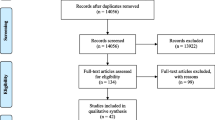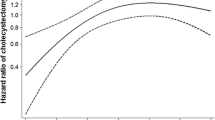Abstract
Inadequate vegetable intake appears to increase colon cancer risk. Since genetic variation in taste influences vegetable preference, we tested associations between bitterness of 6-n-propylthiouracil (PROP), a measure of taste genetics, and number of colonic polyps, a measure of colon cancer risk, in 251 men who underwent screening lower endoscopy. Patients used the general Labeled Magnitude Scale to rate bitterness of 1.6 mg PROP delivered via filter paper. A subset of 86 patients reported weekly vegetable intakes, excluding salad or potatoes. PROP bitterness correlated significantly with polyp number, an effect separate from age-associated increases in polyp number. The PROP–polyp relationship was strongest in men over 66 years, and older men with polyps were most likely to be overweight or obese. In the subset reporting vegetable intake, men who tasted PROP as more bitter consumed fewer vegetables. These preliminary findings suggest that taste genetics may influence colon cancer risk, possibly through intake of vegetables.
Similar content being viewed by others
References
Ries L, Eisner M, Kosary C, Hankey B, Miller B, Clegg L, Mariotto A, Feuer E, Edwards B: SEER Cancer Statistics Review, 1975–2001. Bethesda, MD, National Cancer Institute, 2004
Lamprecht SA, Lipkin M: Chemoprevention of colon cancer by calcium, vitamin D and folate: molecular mechanisms. Natl Rev Cancer 3:601–614, 2003
Gerner EW, Ignatenko NA, Besselsen DG: Preclinical models for chemoprevention of colon cancer. Recent Results Cancer Res 163:58–71, discussion 264–266, 2003
Church RD, Fleshman JW, McLeod HL: Cyclo-oxygenase 2 inhibition in colorectal cancer therapy. Br J Surg 90:1055–1067, 2003
Giovannucci E: Modifiable risk factors for colon cancer. Gastroenterol Clin North Am 31:925–943, 2002
Platz EA, Willett WC, Colditz GA, Rimm EB, Spiegelman D, Giovannucci E: Proportion of colon cancer risk that might be preventable in a cohort of middle-aged US men. Cancer Causes Control 11:579–588, 2000
Satia-Abouta J, Galanko JA, Potter JD, Ammerman A, Martin CF, Sandler RS: Associations of total energy and macronutrients with colon cancer risk in African Americans and Whites: results from the North Carolina colon cancer study. Am J Epidemiol 158:951–962, 2003
Terry P, Giovannucci E, Bergkvist L, Holmberg L, Wolk A: Body weight and colorectal cancer risk in a cohort of Swedish women: relation varies by age and cancer site. Br J Cancer 85:346–349, 2001
Trock BJ, Lanza E, Greenwald P: High fiber diet and colon cancer: a critical review. Prog Clin Biol Res 346:145–157, 1990
McCullough ML, Robertson AS, Chao A, Jacobs EJ, Stampfer MJ, Jacobs DR, Diver WR, Calle EE, Thun MJ: A prospective study of whole grains, fruits, vegetables and colon cancer risk. Cancer Causes Control 14:959–970, 2003
Nkondjock A, Ghadirian P: Dietary carotenoids and risk of colon cancer: case-control study. Int J Cancer 110:110–116, 2004
Erhardt JG, Meisner C, Bode JC, Bode C: Lycopene, beta-carotene, and colorectal adenomas. Am J Clin Nutr 78:1219–1224, 2003
Schatzkin A, Lanza E, Corle D, Lance P, Iber F, Caan B, Shike M, Weissfeld J, Burt R, Cooper MR, Kikendall JW, Cahill J: Lack of effect of a low-fat, high-fiber diet on the recurrence of colorectal adenomas. Polyp Prevention Trial Study Group. N Engl J Med 342:1149–1155, 2000
Caan B, Ballard-Barbash R, Slattery ML, Pinsky JL, Iber FL, Mateski DJ, Marshall JR, Paskett ED, Shike M, Weissfeld JL, Schatzkin A, Lanza E: Low energy reporting may increase in intervention participants enrolled in dietary intervention trials. J Am Diet Assoc 104:357–366, 2004
Curtin K, Bigler J, Slattery ML, Caan B, Potter JD, Ulrich CM: MTHFR C677T and A1298C polymorphisms: diet, estrogen, and risk of colon cancer. Cancer Epidemiol Biomarkers Prev 13:285–292, 2004
Diergaarde B, van Geloof WL, van Muijen GN, Kok FJ, Kampman E: Dietary factors and the occurrence of truncating APC mutations in sporadic colon carcinomas: a Dutch population-based study. Carcinogenesis 24:283–290, 2003
Bartoshuk LM, Duffy VB, Fast K, Snyder DJ: Genetic differences in human oral perception: Advanced methods reveal basic problems in intensity scaling. In Genetic Variations in Taste Sensitivity: Measurement, Significance and Implications. Prescott J, Tepper BJ (eds). New York, Dekker, 2004, pp 1–42
Duffy VB, Lucchina LA, Bartoshuk LM: Genetic variation in taste: potential biomarker for cardiovascular disease risk? In Genetic Variations in Taste Sensitivity: Measurement, Significance and Implications. Prescott J, Tepper BJ (eds). New York, Dekker, 2004, pp 195–228
Snyder LH: Inherited taste deficiency. Science 74:151–152, 1931
Bartoshuk LM, Duffy VB, Miller IJ: PTC/PROP tasting: Anatomy, psychophysics, and sex effects. Physiol Behav 56:1165–1171, 1994
Bartoshuk LM, Duffy VB, Fast K, Green BG, Prutkin JM, Snyder DJ: Labeled scales (e.g., category, Likert, VAS) and invalid across-group comparisons. What we have learned from genetic variation in taste. Food Qual Pref 14:125–138, 2002
Bartoshuk LM, Snyder DJ: Psychophysical measurement of Human Taste Experience. In Handbook of Behavioral Neurobio- logy. Stricker E, Woods S (eds). New York, Plenum Press, 2004, pp 89–107
Bartoshuk LM, Duffy VB, Chapo AK, Fast K, Snyder DJ, Yiee JH, Hoffman HJ, Ko K: From psychophysics to the clinic: Missteps and Advances. Food Qual Pref 15:617–632, 2004
Bartoshuk LM, Green BG, Hoffman HJ, Ko C-W, Lucchina LA, Snyder DJ, Weiffenbach J: Valid across-group comparisons with labeled scales: the gLMS vs magnitude matching. Physiol Behav 82(1):109–114, 2004
Miller IJ, Reedy FE: Variations in human taste bud density and taste intensity perception. Physiol Behav 47:1213–1219, 1990
Tepper BJ, Nurse RJ: Fat perception is related to PROP taster status. Physiol Behav 61:949–954, 1997
Kim UK, Jorgenson E, Coon H, Leppert M, Risch N, Drayna D: Positional cloning of the human quantitative trait locus underlying taste sensitivity to phenylthiocarbamide. Science 299:1221–1225, 2003
Bartoshuk LM, Duffy VB, Fast K, Kveton JF, Lucchina LA, Phillips MN, Prutkin JM, Reed DR, Snyder DJ: What makes a supertaster? Chem Senses 26:1074, 2001 (abstract)
Bartoshuk L, Davidson A, Kidd J, Kidd K, Speed W, Pakstis A, Reed D, Synder D, Duffy V: Supertasting is not explained by the PTC/PROP gene. Chem Senses, in press (abstract)
Duffy VB, Davidson AC, Kidd JR, Kidd KK, Speed WC, Pakstis AJ, Reed DR, Snyder DJ, Bartoshuk LM: Associations between PTC/PROP gene, 6-N-propylthiouracil (PROP) bitterness and alcohol intake. Alcohol Chin Exp Res 28:1629–1637, 2004
Engel E, Baty C, Issanchou S, Martin N: Acceptance and preference for cooked cauliflower: relationship with consumer sensitivity and product composition. Paper presented at the 5th Pangborn Sensory Science Symposium. Boston, MA, 2003
Bartoshuk LM: Genetic and pathological taste variation: What can we learn from animal models and human disease? In The Molecular Basis of Smell and Taste Transduction, Ciba Foundation Symposium 179. Chadwick D, Marsh J, Goode J (eds). New York, John Wiley and Sons, 1993, pp 251–267
Fox AL: A new approach to explaining food preferences. Paper presented at the American Chemical Society, 1954
Fischer R, Griffin F, England S, Garn S: Taste thresholds and food dislikes. Nature 191:1328, 1961
Fischer R, Griffin F, Kaplan AR: Taste thresholds, cigarette smoking, and food dislikes. Medicina Experimentalis 9:151–167, 1963
Drewnowski A, Rock CL: The influence of genetic taste markers on food acceptance. Am J Clin Nutr 62:506–511, 1995
Drewnowski A, Henderson SA, Shore AB: Taste responses to naringin, a flavonoid, and the acceptance of grapefruit juice are related to genetic sensitivity to 6-n-propylthiouracil. Am J Clin Nutr 66:391–397, 1997
Gayathri DA, Henderson SA, Drewnowski A: Sensory acceptance of Japanese green tea and soy products is linked to genetic sensitivity to 6-n-propylthiouracil. Nutr Cancer 29:146–151, 1997
Kaminski LC, Henderson SA, Drewnowski A: Young women’s food preferences and taste responsiveness to 6-n-propylthiouracil (PROP). Physiol Behav 68:691–697, 2000
Drewnowski A, Henderson SA, Hann CS, Berg WA, Ruffin MT: Genetic taste markers and preferences for vegetables and fruit of female breast care patients. J Am Diet Assoc 100:191–197, 2000
Keller KL, Tepper BJ: Genetic taste sensitivity to 6-n-propylthiouracil influences food preference and reported intake in preschool children. Appetite 38:3–12, 2002
Turnbull B, Matisoo-Smith E: Taste sensitivity to 6-n-propylthiouracil predicts acceptance of bitter-tasting spinach in 3-6-y-old children. Am J Clin Nutr 76:1101–1105, 2002
Duffy V, Davidson A, Bartoshuk L, Kidd J, Kidd K: Revealing associations between PTC/PROP gene, 6-n-propylthiouracil (PROP) bitterness and vegetable intake. 2004 Experimental Biology meeting abstracts [accessed at http://select.biosis.org/faseb/2004.html]. FASEB 19, abstract 6780
Milunicová A, Jandová A, Laurová L, Novotná J, Skoda V: Hereditary blood and serum types, PTC test and level of the fifth fraction of serum lactatedehydrogenase in females with gyneological cancer (II. Communication). Neoplasma 16:311–316, 1969
Duffy VB: Associations between Oral Sensation, Dietary Behaviors and Risk of Cardiovascular Disease (CVD). Appetite 43(1):5–9, 2004
Tepper BJ: 6-n-Propylthiouracil as a genetic marker for fat intake, obesity, and chronic disease risk: Current evidence and future promise. In Genetic Variation in Taste Sensitivity. Prescott J, Tepper BJ (eds). New York, Marcel Dekker, 2004, pp 155–177
Lucchina LA: 6-n-propylthiouracil status: Genetic determinant of diet-related behaviors and nutritional status in older females. Doctoral dissertation. University of Connecticut, 1995
Tepper BJ, Ullrich NV: Influence of genetic taste sensitivity to 6-n-propylthiouracil (PROP), dietary restraint and disinhibition on body mass index in middle-aged women. Physiol Behav 75:305–312, 2002
Duffy VB, Peterson JM, Dinehart ME, Bartoshuk LM: Genetic and environmental variation in taste: Associations with sweet intensity, preferences and intake. Top Clin Nutr 18:209–220, 2003
Duffy VB, Bartoshuk LM: Food acceptance and genetic variation in taste. J Am Diet Assoc 100:647–655, 2000
Duffy V, Peterson J, Bartoshuk L: Associations between taste genetics, oral sensation and alcohol intake. Physiol Behav 82(2–3):435–445, 2004
Snyder DJ, Duffy VB, Chapo AK, Hoffman H, Bartoshuk LM: Otits media influences body mass index by interacting with sex, age and taste. Chem Senses 28:12, 2003 (abstract)
Bartoshuk LM, Duffy VB, Reed D, Williams A: Supertasting, earaches, and head injury: Genetics and pathology alter our taste worlds. Neurosci Biobehav Rev 20:79–87, 1996
Chapo AK, Bartoshuk LM, Ilich JZ, Duffy VB: Age-related differences in fat perception and dietary behaviors. Chem Senses 27:A19, 2002 (abstract)
Duffy VB, Fast K, Lucchina LA, Bartoshuk LM: Oral sensation and cancer. In Principles & Practice of Palliative Care and Supportive Oncology, ed 2. Berger AM, Portenoy RK, Weissman DE (eds). Philadelphia, PA, Lippincott Williams & Wilkins, 2002, pp 178–193
Green BG, Shaffer GS, Gilmore MM: A semantically-labeled magnitude scale of oral sensation with apparent ratio properties. Chem Senses 18:683–702, 1993
Bartoshuk LM: Comparing sensory experiences across individuals: Recent psychophysical advances illuminate genetic variation in taste perception. Chem Senses 25:447–460, 2000
Berkeley Nutrition Services. 2000. http://www.nutritionquest.com. Accessed July 4, 2004
Tabachnick B, Fidell L: Using Multivariate Statistics (ed 2nd). Boston, Allyn & Bacon, 2001
Wright J, Wang C, Kennedy-Stephenson J, Ervin R: Dietary intake of ten key nutrients for public health, United States: 1999–2000. Advance Data from Vital and Health Statistics, No. 334. Hyattsville, MD, National Center for Health Statistics, 2003
Prutkin JM, Duffy VB, Etter L, Fast K, Gardner E, Lucchina LA, Snyder DJ, Tie K, Weiffenbach J, Bartoshuk LM: Genetic variation and inferences about perceived taste intensity in mice and men. Physiol Behav 69:161–173, 2000
Lanza E, Schatzkin A, Daston C, Corle D, Freedman L, Ballard-Barbash R, Caan B, Lance P, Marshall J, Iber F, Shike M, Weissfeld J, Slattery M, Paskett E, Mateski D, Albert P: Implementation of a 4-y, high-fiber, high-fruit-and-vegetable, low-fat dietary intervention: results of dietary changes in the Polyp Prevention Trial. Am J Clin Nutr 74:387–401, 2001
Author information
Authors and Affiliations
Corresponding author
Additional information
This work was supported by a MAVERIC grant from the Veterans Administration (M.D.B.) and by NIDCD Grant DC00283 (L.M.B. and V.B.D.).
Rights and permissions
About this article
Cite this article
Basson, M.D., Bartoshuk, L.M., DiChello, S.Z. et al. Association Between 6-n-Propylthiouracil (PROP) Bitterness and Colonic Neoplasms. Dig Dis Sci 50, 483–489 (2005). https://doi.org/10.1007/s10620-005-2462-7
Received:
Accepted:
Issue Date:
DOI: https://doi.org/10.1007/s10620-005-2462-7




